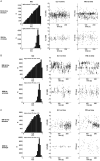Binaural Recordings in Natural Acoustic Environments: Estimates of Speech-Likeness and Interaural Parameters
- PMID: 33331242
- PMCID: PMC7750905
- DOI: 10.1177/2331216520972858
Binaural Recordings in Natural Acoustic Environments: Estimates of Speech-Likeness and Interaural Parameters
Abstract
Binaural acoustic recordings were made in multiple natural environments, which were chosen to be similar to those reported to be difficult for listeners with impaired hearing. These environments include natural conversations that take place in the presence of other sound sources as found in restaurants, walking or biking in the city, and so on. Sounds from these environments were recorded binaurally with in-the-ear microphones and were analyzed with respect to speech-likeness measures and interaural difference measures. The speech-likeness measures were based on amplitude-modulation patterns within frequency bands and were estimated for 1-s time-slices. The interaural difference measures included interaural coherence, interaural time difference, and interaural level difference, which were estimated for time-slices of 20-ms duration. These binaural measures were documented for one-fourth-octave frequency bands centered at 500 Hz and for the envelopes of one-fourth-octave bands centered at 2000 Hz. For comparison purposes, the same speech-likeness and interaural difference measures were computed for a set of virtual recordings that mimic typical clinical test configurations. These virtual recordings were created by filtering anechoic waveforms with available head-related transfer functions and combining them to create multiple source combinations. Overall, the speech-likeness results show large variability within and between environments, and they demonstrate the importance of having information from both ears available. Furthermore, the interaural parameter results show that the natural recordings contain a relatively small proportion of time-slices with high coherence compared with the virtual recordings; however, when present, binaural cues might be used for selecting intervals with good speech intelligibility for individual sources.
Keywords: binaural recordings; everyday-life recordings; interaural differences; natural environments; speech-likeness.
Conflict of interest statement
Figures








References
-
- Beutelmann, R., and Brand, T. (2006) Prediction of speech intelligibility in spatial noise and reverberation for normal-hearing and hearing-impaired listeners. Journal of the Acoustical Society of America, 120(1), 331–42. Doi: 10.1121/1.2202888. - PubMed
Publication types
MeSH terms
LinkOut - more resources
Full Text Sources

